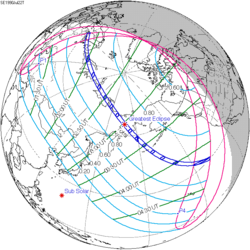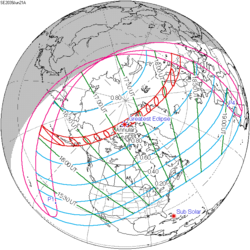| Annular eclipse | |
| Gamma | −0.9457 |
|---|---|
| Magnitude | 0.967 |
| Maximum eclipse | |
| Duration | 123 s (2 min 3 s) |
| Coordinates | 71°00′S22°12′W / 71°S 22.2°W |
| Max. width of band | 373 km (232 mi) |
| Times (UTC) | |
| Greatest eclipse | 19:31:24 |
| References | |
| Saros | 121 (59 of 71) |
| Catalog # (SE5000) | 9486 |
An annular solar eclipse occurred at the Moon's ascending node of orbit on Friday, January 26, 1990, [1] with a magnitude of 0.967. A solar eclipse occurs when the Moon passes between Earth and the Sun, thereby totally or partly obscuring the image of the Sun for a viewer on Earth. An annular solar eclipse occurs when the Moon's apparent diameter is smaller than the Sun's, blocking most of the Sun's light and causing the Sun to look like an annulus (ring). An annular eclipse appears as a partial eclipse over a region of the Earth thousands of kilometres wide. Occurring 7.1 days after apogee (on January 19, 1990, at 16:00 UTC), the Moon's apparent diameter was smaller. [2]
Contents
- Eclipse timing
- Places experiencing partial eclipse
- Eclipse details
- Eclipse season
- Related eclipses
- Eclipses in 1990
- Metonic
- Tzolkinex
- Half-Saros
- Tritos
- Solar Saros 121
- Inex
- Triad
- Solar eclipses of 1990–1992
- Saros 121
- Metonic series
- Tritos series
- Inex series
- Notes
- References
- External links
Annularity was visible from a part of Antarctica. A partial eclipse was visible for parts of Antarctica, southern and eastern South America, and New Zealand.

































































































